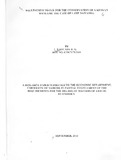| dc.description.abstract | Wetlands are among the most productive ecosystems on the earth. They allow interaction
between water, soil, vegetation and light all the year round or during a great part of the
year. The depth of the water is such that it allows photosynthesis to occur, making
wetlands productive life supporting ecosystems. It is this association of water, light, soil
and plants that typify various wetlands of Kenya that are famous for their avifauna and
fisheries resources.
There should therefore be an aim to create awareness of the values, uses and threats to
our wetlands. Means should be put in place to help in creating and promoting education
and awareness at all levels of the society, especially among government, policy and
decision makers, developers, land owners, and local communities. Another objective
should entail promoting better understanding and appreciation of the functions and values
of wetlands though research and monitoring and supporting community conservation
initiatives by provision of technical support, linkages and mobilization.
The results showed that the local communities are willing to pay an amount of Kshs 171
per annum towards the conservation of L. Naivasha. This is an encouraging figure since
if it is enforced then it would ease the governments burden towards conservation of the
lake. The government and other interested parties (NGOs and local communities) should
target the middle aged group since it is the one which is the most aware of the benefits of
L. Naivasha conservation. Moreso, they are the most educated and have got surplus -
income, their family sizes are few and hence understands more of the social economic
consequences of L. Naivasha depletion.
From the study it should be recommended that since most wetlands are traditional water
sources and the only available grazing areas for the pastorals communities during
drought. It should be advisable therefore to integrate the traditional management
program. Appropriate water management including review of water abstraction rights in
relation to the available water in order to ensure sustainable agricultural and urban
development which takes into account the need to protect the lake and biodiversity
should be taken into consideration. | en |

